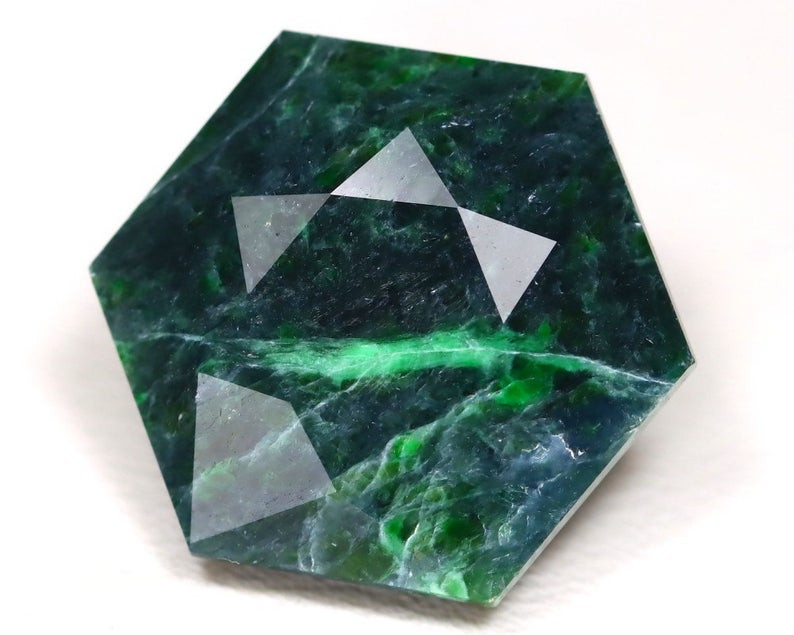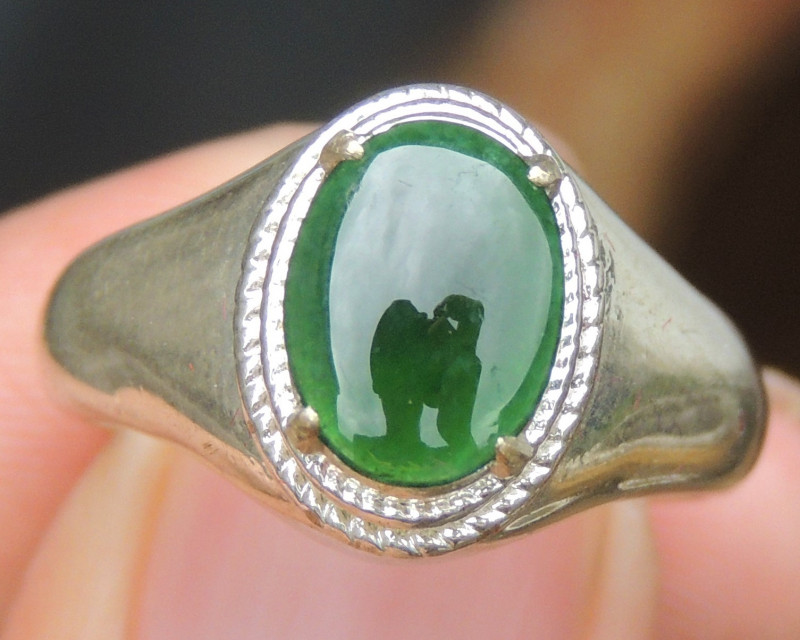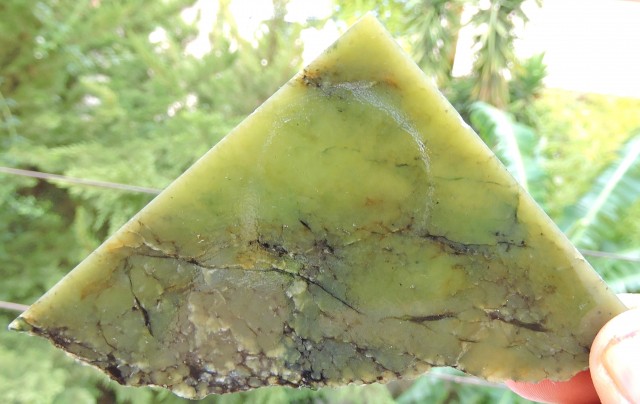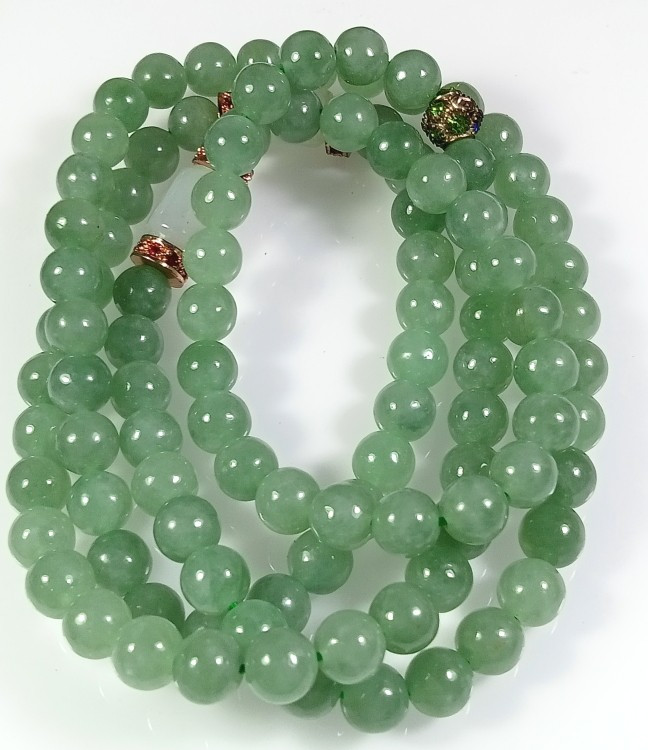
翡翠の宝石:意味、特性、用途など
 幸運が欲しい?究極の幸運のお守り、翡翠をご用意しました!翡翠とは、ジェダイトとネフライトという、驚くほどよく似た2種類の宝石を指します。何世紀にもわたって愛されてきた翡翠は、世界中の多くの文化で特別な位置を占めています。
幸運が欲しい?究極の幸運のお守り、翡翠をご用意しました!翡翠とは、ジェダイトとネフライトという、驚くほどよく似た2種類の宝石を指します。何世紀にもわたって愛されてきた翡翠は、世界中の多くの文化で特別な位置を占めています。
翡翠は主に中国と結び付けられますが、世界中の他の地域でも翡翠は文化圏に取り入れられています。アメリカ合衆国では、ワイオミング州とアラスカ州が翡翠を州の公式宝石として崇めています。
2008年の北京オリンピックをご覧になった方は、メダルに緑色がちらりと見えたことに気づいたかもしれません。中国政府は、1位、2位、3位のメダルに翡翠を加えることで、史上初の宝石で飾られたオリンピックメダルという歴史を築きました。
翡翠について、まだまだ解明すべきことがたくさんあります。でも、その前に、翡翠とは何か?
翡翠とは何ですか?
翡翠は、輝きに満ちた半貴石です。3月生まれの方は、翡翠の誕生石に恵まれています!翡翠は3月の神秘的な誕生石で、陽気な3月の人にポジティブなエネルギーを吹き込んでくれます。
占星術に興味がありますか?翡翠は、金星の配下にある2つの星座、牡牛座と天秤座の守護石です。どちらの星座も美を深く愛しているので、ゴージャスな翡翠のジュエリーはきっと気に入ってくれるでしょう!
感謝の気持ちと言えば、翡翠は結婚12周年の伝統的な宝石です!感謝の気持ちを表すのに、「心の石」そのもの以上にふさわしい贈り物があるでしょうか?
鉱物の特性
ご存知の通り、翡翠はジェダイト(硬玉)またはネフライト(軟玉)を指すことがあります。ジェダイトとネフライトはどちらも、小さな結晶が絡み合った変成岩です。それぞれの石は硬度や化学組成が異なります。
では、翡翠はいったい何からできているのでしょうか?
翡翠はナトリウム・アルミニウムケイ酸塩、ネフライトはカルシウム・マグネシウムケイ酸塩です。 鉱物の硬度を表すモース硬度スケールでは、翡翠は6.5~7、ネフライトは6~6.5です。
翡翠は最も硬い石ではありませんが、最も強靭な石です。硬度は傷がつきにくい性質ですが、靭性は鋭い打撃などの機械的な衝撃に耐える石の能力を指します。なぜ翡翠が最も強いのでしょうか?それは、石を構成する結晶が複雑に絡み合っているからです。
以下では、必要に応じてジェダイトとネフライトを区別しながら、翡翠のその他の特性について概説します。

翡翠の仕様と特徴
色: 通常は緑。白、オレンジ、黄色、ラベンダー、黒もあります。
結晶構造:単斜晶系
光沢: 翡翠の場合はガラス質~ガラス質、軟玉の場合はガラス質~脂質
透明度: ジェダイトは半透明から不透明、ネフライトは半透明から不透明
屈折率:翡翠:1.64~1.68、軟玉:1.60~1.64
密度: 翡翠の場合3.25~3.38、軟玉の場合2.90~3.08
卵割:まれに観察される
破片:ジェダイトの場合は破片状、ネフライトの場合は破片状から粒状
発光: ジェダイトは存在するが弱い、緑色の長波長紫外線と短波長紫外線を発する。ネフライトは存在しない。
シャトヤンシー:台湾産のネフライト石の一部に見られる
科学はさておき、翡翠石の意味にはどんな物語があるのでしょうか?
翡翠の宝石の意味
ジェイドの名前はスペイン語の「ピエドラ・デ・イハダ」に由来し、「脇腹の痛みに効く石」を意味します。しかし、なぜでしょうか?
1500年代、中央アメリカを訪れたスペインの探検家たちは、先住民が翡翠を横に当てて腎臓の病気を治しているのを目撃しました。ラテン語の「lapis nephriticus 」は「腎臓結石」とも訳されます。
翡翠は象徴的に、知恵、繁栄、そして美徳を象徴するようになりました。また、平穏や愛を象徴する解釈もあります。
古代文化は翡翠に独自の意味を込めました。古代マヤ人とアステカ人は、翡翠が生と死の輪廻を象徴すると信じていました。翡翠は、霊界への入り口となる呼吸の精霊「イク」と彼らを結びつけていました。
古代中国では、翡翠は王族、美、そして徳の象徴でした。実際、中国語で翡翠を意味する「玉」は「王家の宝石」を意味します。例えば、翡翠の龍は力と繁栄を象徴しています。
古代の学者、徐深は、翡翠が人類の五つの美徳、すなわち慈愛、誠実、智慧、勇気、謙遜を象徴すると信じていました。哲学者の孔子も同様の考えを持ち、翡翠は「君子の美徳」の原則をすべて体現していると主張しました。
中国の翡翠彫刻にはそれぞれ異なる意味がありますが、特に重要なのは「比」と「叢」です。比は中央に穴が開いた円盤で、天を象徴します。一方、叢は内側が丸い四角い容器で、地を象徴します。
古代文化に共通する特徴の一つは、長寿のために翡翠が使われていたことです。多くの人々は、翡翠の宝石が活力と強さに満ちた長寿を与えてくれると信じていました。
現在、翡翠は何に使われているのでしょうか?

翡翠の治癒効果
他のヒーリングストーンと同様に、翡翠は様々な用途に活用できるエネルギーを発します。全体的に見て、翡翠は他の 緑色の宝石と同様に、バランス、希望、そして癒しを促進します。
特定の治癒特性に関して言えば、翡翠にはどのような効果があるのでしょうか?
身体の治癒
翡翠の語源を考えると、腎臓病を治す効果があるのは当然のことです。その他の身体的な治癒効果としては、免疫システムの強化や血液中の毒素除去などが挙げられます。
翡翠はスキンケアの世界にも衝撃を与え、翡翠フェイシャルローラーの人気が爆発的に高まりました。顔の上を転がすと、翡翠の持つ冷たさが赤みを抑え、顔色を明るくし、血行を促進する効果があります。
感情的な癒し
翡翠の感情的な癒しの力は、あなたの身体と周囲の世界との関係性に焦点を合わせます。翡翠は、あなたの身体と感情の状態に意識を向けさせることで、あなたの苦しみの根源を特定するのに役立ちます。そして、翡翠の叡智が、あなたを解決策へと導いてくれるでしょう。
自分自身とより調和することで自己愛が増し、その愛を他の人と分かち合うときに自信が増します。
チャクラヒーリング
翡翠はハートチャクラのバランスを整えるのに最適です。ハートチャクラは愛を与え、受け取る場所であり、心と体のバランスを保つ場所です。
翡翠はハートチャクラを開き、豊かな感性を感じ、自分自身を含め、すべての人の長所を見出すことができます。ハートチャクラがブロックされていると、感情が抑圧され、恐怖を感じ、優柔不断な気持ちになります。
決断力がないといえば、翡翠を一つだけ選ぶのに苦労していませんか?翡翠を選ぶ際に注意すべき点について、ぜひこの記事をお読みください!

翡翠の宝石特性
すべての宝石の価値はいくつかの特性によって決まりますが、その特性は石によって異なります。翡翠の場合、注目すべき主な特性は、石のカット、色、透明度、カラット重量、そして処理です。
カット
翡翠は強度が高いため、ほぼあらゆるカットが可能です。最高品質の翡翠は、素材を無駄にしないよう、 カボションカットやファセットカットのジュエリーに加工されることが多いです。
宝石細工師は、翡翠の原石全体を使ってホロリスの指輪やブレスレットを作ることもありますが、ホロリスを切る際に無駄になる翡翠の量が多いため、これらの作品は非常に高価になります。
翡翠の彫刻は何世紀も前から存在し、大きな文化的意義を持っています。中国文化において人気の翡翠の彫刻には、神聖な動物の像や仏像などの宗教的な像があります。
色
ジェダイトとネフライトはどちらも、アップルグリーンから、誰もが憧れるエメラルドグリーンの「インペリアル・ジェイド」まで、様々な色合いのグリーンがあります。どちらの石も、縞模様やまだら模様が特徴的で、渦巻状のテクスチャーを思わせる錯覚を引き起こします。
しかし、翡翠はネフライトよりも多くの色があります。緑色以外にも、黄色、赤橙色、ラベンダー色、ピンク色、青、黒、茶色、灰色など、様々な色があります。つまり、ほぼあらゆる色を望み得るのです。
ネフライト翡翠には、緑以外にも白、黒、茶色、そして中国では「羊脂翡翠」と呼ばれる淡黄色の品種など、さまざまな色があります。
主な違いは、ネフライトの色がジェダイトの色よりも落ち着いていることです。

透明度と質感
石のクラリティグレードは、 内包物によって決まります。翡翠は特定のクラリティグレードに分類されるわけではありませんが、内包物のある翡翠の方が一般的であるため、内包物のない翡翠よりも価値が低くなります。
翡翠の微細な結晶の大きさは、その質感に影響を与えます。翡翠の結晶粒の大きさは、細粒、中粒、粗粒の3種類に分類されます。細粒の翡翠は、最も滑らかな質感と魅力的な光沢を放ちます。
カラット重量
カラット重量は翡翠、特にジェダイトの価値を大きく左右します。数カラットを超える天然ジェダイトは非常に希少であるため、サイズが大きくなるとカラットあたりの価格が大幅に上昇します。
処理
お手持ちの翡翠が本物か模造品か、お悩みではないでしょうか。模造品は一般的ではありませんが、加工された翡翠はよく見かけます。翡翠は、様々な理由から染色、漂白、含浸、コーティング、加熱などの加工が施されている場合があります。
翡翠は、染色、漂白、加熱といった処理を施すことで、通常、より美しい色合いになります。例えば、翡翠に茶色の色合いが見られる場合、宝石商は酸で漂白することがあります。
翡翠にポリマーを含浸またはコーティングすることで、破損に対する保護層がさらに強化されます。一般的に、染色または漂白された翡翠はより脆くなるため、ポリマーを含浸させることで破損を防ぐことができます。
中国では翡翠の処理が非常に一般的であるため、石の加工度合いを3段階に等級分けするシステムが考案されました。グレードAの翡翠は最高ランクで、未処理の宝石(コーティングのみの場合もあります)を指します。グレードCの翡翠は、染色や含浸処理が施された宝石を指します。
中国における翡翠の加工は実は 13 世紀にまで遡りますが、翡翠の歴史はさらに古く遡ります。

翡翠の歴史
翡翠の歴史は7000年以上前に始まり、様々な社会が翡翠から武器や道具を彫ったことから始まりました。翡翠の文化的重要性は東アジアと中央アメリカで最も顕著でした。
翡翠を表す漢字「玉」の起源は紀元前2000年頃まで遡ります。新石器時代の中国では、翡翠は様々な精神的な意味を持っていました。翡翠の工芸品は自然と天の繋がりを象徴し、龍や亀といった神聖な動物と共に描かれることが多かったのです。
周王朝が始まると、中国の翡翠の定義は精神的なものから、社会的な力と権威へと変化しました。例えば、漢王朝の王族のために用意された、数千個の翡翠で作られた儀式用の屍衣である翡翠の埋葬服が挙げられます。
おそらく最も有名な翡翠の鑑定家は乾隆帝でしょう。18世紀の治世中、皇帝は膨大な量の翡翠を収集し、翡翠について熱烈な詩を詠むほどでした。
マヤ人は翡翠を同様に崇敬していました。儀式用の仮面、笏、ペンダントなど、翡翠製の装飾品を身に着けることは、マヤの長老や王族にのみ許されていました。翡翠には宗教的な意味合いがあり、例えば、太陽神キニチ・アハウを象徴する翡翠のペンダントを身に着ける貴族もいました。
近代では、1863年にフランスの鉱物学者アレクシ・ダムールが、ジェダイトとネフライトが化学的に異なることを発見し、翡翠の歴史に大きな足跡を残しました。
ダムールの発見につながった進歩以来、科学者たちはジェダイトとネフライトがどのように形成されるのかを解明することができました。
翡翠の起源と産地
翡翠とネフライトはどちらも変成岩の中で形成されますが、その形成環境は異なります。翡翠は地中深くの高温と高圧を必要とし、浸食や地震によってのみ生成されます。
ネフライトはジェダイトよりもはるかに少ない圧力で生成され、地表に非常に近い場所で形成されます。地表に近いため、ネフライトは見つけやすく、海岸でよく見られます。ネフライトはジェダイトよりも豊富ですが、その形成過程により、ジェダイトよりも強度が低くなります。
翡翠が形成されたら、どこで見つけられるでしょうか?

採掘場所
翡翠の産地として圧倒的に豊富なのはミャンマーです。多くの情報源によると、世界の翡翠の少なくとも70%はミャンマー産と推定されています。また、ミャンマーはインペリアル・ジェイドの唯一の産地でもあります。
興味深いことに、翡翠は中国の主要産地であるにもかかわらず、中国では翡翠輝石ではなく軟玉のみが生産されている。
時とともに小規模な翡翠鉱山が出現し、ジェダイトとネフライトを産出するものもあれば、どちらか一方のみを産出するものもありました。これらの鉱山には以下が含まれます。
オーストラリア(ネフライト)
ブラジル(ネフライト)
キューバ(ジェダイト)
カナダ(両方)
グアテマラ(翡翠)
日本(翡翠)
カザフスタン(翡翠)
ポーランド(ネフライト)
ロシア(両方)
台湾(ネフライト)
トルコ(翡翠)
米国 - アラスカ、カリフォルニア、ワイオミング(両方)
ジンバブエ(ネフライト)
産地に関係なく、翡翠はあなたが大切に扱う限り、どこへ行っても生涯の友となることができます。
翡翠のケアとメンテナンス
翡翠は柔らかい布と温かい石鹸水で洗うことができます。石が未処理の場合は、スチームまたは超音波洗浄機で洗浄できます。
石が加工されているかどうかわからない場合は、安全のために石鹸水を使用してください。石の色と質感を保つために、刺激の強い化学薬品は避けてください。
翡翠とネフライトはどちらも非常に硬い宝石なので、壊れる可能性は低いです。しかし、トパーズやクォーツのような硬い石によって傷がつく可能性があるため、翡翠は他の宝石とは分けて保管するのが最善です。
最後に価格についてお伺いします。翡翠は高価ですか?

翡翠の価格と価値
翡翠の価格は、ジェダイトかネフライトかによって大きく異なります。ネフライトは人気の宝石ですが、ジェダイトははるかに希少で、高値で取引されます。
平均すると、ネフライト翡翠の価格は 1 カラットあたり約 0.04 ~ 0.40 ドルで、ほとんどのネフライト ジュエリーの価格は 30 ~ 60 ドルです。
ただし、ネフライトの産地によって価格は変動する場合があります。例えば、カナダ産のネフライトは1カラットあたり0.04ドルから、中国産のホワイトネフライトは1カラットあたり30ドルからとなります。
ジェダイトの価格は、希少な種類でない限り、1カラットあたり70ドルから410ドル程度です。「インペリアル・ジェード」は最も高価な色で、1カラットあたり1万ドルから300万ドルです。
ちなみに、彩度の高い色は落ち着いた色よりも高価です。透明度という点では、半透明の翡翠が最も価値があります。
プロのヒント:翡翠の価格は、中国の祝日の時期に高騰することが多いです。お得に購入するには、この時期を避けましょう。
自分だけの天国の宝石を手に入れましょう!
素晴らしい翡翠の宝石についてすべてご存知になったので、この石が広く愛されている理由が簡単にわかります。
表面的には、翡翠はただの美しい緑色の石に見えるかもしれません。しかし、その奥には、何世紀にもわたって人々の心を動かしてきた光と愛が満ち溢れています。
願わくば、翡翠は、自分自身の中にどんな欠点が見受けられるとしても、世界と共有する価値のある光がまだあることを思い出させてくれるでしょう。
中国のことわざにこうあります。「翡翠の上の小さな点がその輝きを曇らせることはない。」
Gemstone Encyclopedia検索
最新記事
レインボーラティスサンストーンは、様々な内包物によって3つのゴージャスな光学的効果を持つ長石の一種です。燃えるように鮮やかな色合いと格子模様が、コレクターにとって希少な宝石となっています。
12th Jan 2026
チューライトは、ゾイサイト鉱物ファミリーに属する、鮮やかなバラ色の色合いを示す希少なノルウェー産の宝石で、ジュエリーのセッティングやペンダントによく使用されます。
6th Jan 2026
記事のカテゴリ
How To's is where you will find helpful articles from gem Rock Auctions on how to cut gemstones, select gemstones and buy gemstones.
9記事数

